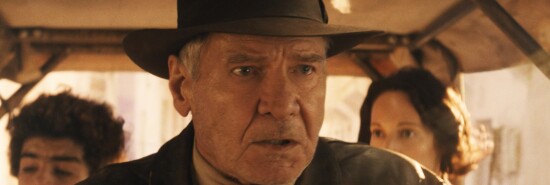
Indiana Jones and the Dial of Destiny: A tired dance with nostalgia
Harry Khachatrian
The original Indiana Jones films were a thrilling escape into an imaginative world where an academic — an archaeologist — was as captivating and charismatic as any muscle-clad ’80s action hero. Director Steven Spielberg crafted the franchise as a tribute to the pulp serials of the early 20th century, imbuing the films with a sense of exploration, adventure, and excitement.
Disney‘s The Dial of Destiny, however, isn’t quite the escapist fantasy its predecessors were. Instead, it often feels like a bloated nostalgia ploy, an attempt to extract any remaining commercial value from this storied property, leaving you searching for an exit rather than being absorbed in the adventure. To its credit, the film is rarely boring. But it does quickly get weary.
SUPREME COURT CHECKS BIDEN’S OVERREACH ON STUDENT LOANS
The plot involves a group of covert Nazis who believe that mathematician Archimedes’s lost device, the Dial of Destiny, holds the power to resurrect the Third Reich. Thus, Indiana Jones is once again thrust into a globe-trotting adventure to stop them.
Harrison Ford reprises his role as the cavalier archaeologist, attired in his signature fedora, leather jacket, and whip. Opening with a flashback set amid the latter moments of World War II, the prologue features a CGI de-aged Harrison Ford. Through computer gimmickry, the digitized avatar of Ford’s younger self barrels through a Nazi freight train in search of a lost relic. It is here that he first comes across Archimedes’s fabled Dial, the object that sets the plot in motion.
As the first act fast-forwards into the present, Indiana has aged into an alcoholic misanthrope, scraping by in a disheveled apartment and teaching benighted college students. Underscoring both the film’s 1960s-era backdrop and Indiana’s curmudgeonly countenance, an early scene features the grizzled senior bellowing at his hippie neighbors for blaring the Beatles and Bowie through the building.
It is only when his goddaughter, Helena Shaw (Phoebe Waller-Bridge), resurfaces in his life that Ford is dragged back into his daring escapades. Waller-Bridge, best known for her fourth-wall flirtations in the inventive dark comedy Fleabag, is a brilliant comedy writer and actress. But a natural action movie heroine she is not.
Cleverly leveraging her strengths, Waller-Bridge draws from fragments of her Fleabag persona. Lending her quirky comedic timing to Indiana Jones’s lighthearted tone, she excels in comedic relief. In another scene where Indiana finds her trying to auction off priceless relics in a Moroccan club, she awkwardly reveals the local mob boss is her jealous ex-lover, as she and Indiana soon find themselves escaping under duress, chased by both Nazis and mobsters.
Inexplicably intertwined in this world of crime, Shaw first feigns interest in her godfather’s work to get closer to the Dial, hoping to pawn it off to pay her debts. The plot evidently needed a character arc through which to build their relationship, as through the first two-thirds of the film she routinely admonishes and undermines Indiana in a harsh, resentful tone. But her motivations are never divulged; she just appears to hate him without cause, making her character feel shallow and undeveloped.
Despite the film’s shortcomings, however, the reprise of John Williams’s iconic main theme, played against the backdrop of Indiana pulling off some impossible stunt, never fails to evoke the franchise’s past glory and leave you wondering if you can mimic your favorite hero and pull off wearing a fedora with the polished aplomb of Harrison Ford (you can’t).
CLICK HERE TO READ MORE FROM THE WASHINGTON EXAMINER
The stunts in Dial of Destiny, albeit in ample supply, are distinctly artificial, with a heavy reliance on CGI and green screens. Whereas Spielberg filmed action sequences in long, fluid takes, often from a distance, allowing you to fully appreciate the choreography and understand the geography of the scene, director James Mangold instead relies on frenzied jump cuts and shaky filming to obscure Ford’s slower movements, resulting in sequences that rarely evoke any sense of danger and feel more akin to a video game.
A particularly revealing moment occurs midway through the film when Shaw criticizes Indiana’s archaeological pursuits as capitalist exploitation. Ironically interpreted as Waller-Bridge’s fiddling with the fourth wall, it astutely diagnoses the main problem plaguing The Dial of Destiny. The film excavates the franchise’s eminent past but adds little of substance, merely manipulating nostalgia to placate Disney’s insatiable avarice. One could imagine Indiana Jones himself rejecting the premise of the film, quipping, “That belongs in a museum.”
Harry Khachatrian (@Harry1T6) is a film critic for the Washington Examiner’s Beltway Confidential blog and a computer engineer in Toronto, pursuing his MBA.
